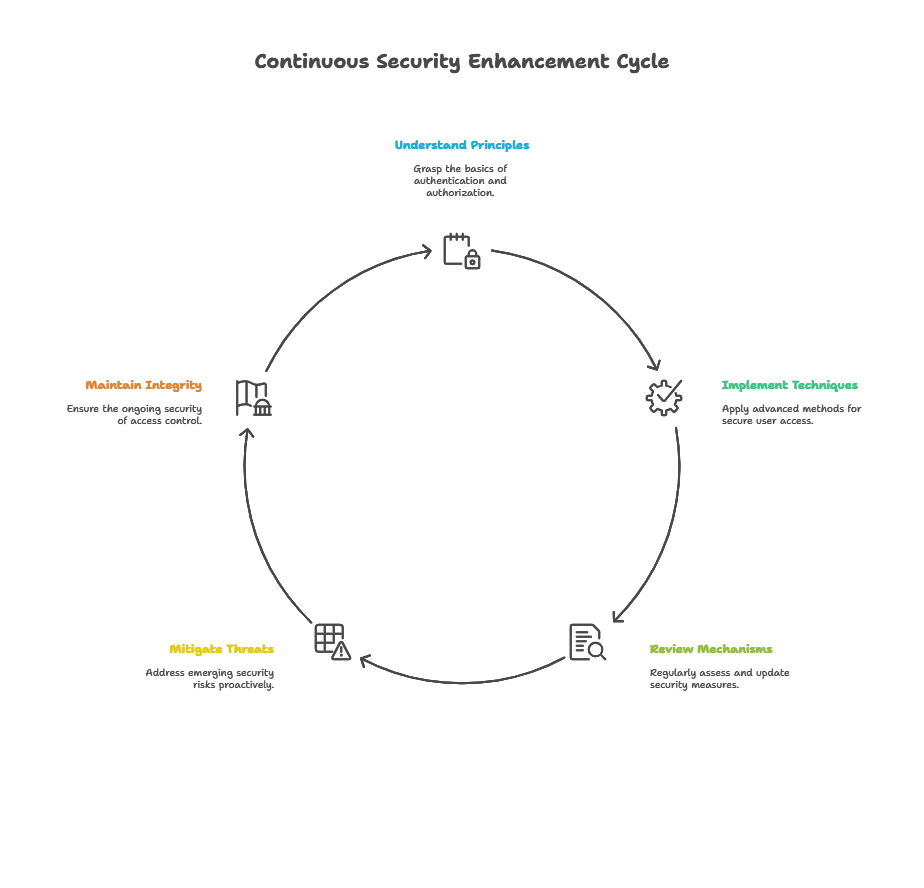Authentication and Authorization
Authentication and authorization are essential aspects of building secure web applications. Authentication verifies the identity of users, while authorization determines what actions they are allowed to perform within the application. In this chapter, we'll explore these concepts in detail, covering basic authentication mechanisms to advanced authorization techniques in Go.
Authentication
- User Authentication: The process of verifying the identity of users, usually through credentials such as username and password.
- Session Management: Handling user sessions to maintain their authenticated state across multiple requests.
- Security Measures: Implementing secure password storage, encryption, and protection against common attacks like brute force and session hijacking.
func loginHandler(w http.ResponseWriter, r *http.Request) {
// Check username and password from request
username := r.FormValue("username")
password := r.FormValue("password")
// Verify credentials (e.g., from a database)
if isValidUser(username, password) {
// Create session for authenticated user
sessionID := createSession(username)
// Set session cookie
http.SetCookie(w, &http.Cookie{
Name: "sessionID",
Value: sessionID,
// Set other cookie attributes (e.g., secure, HttpOnly)
})
http.Redirect(w, r, "/dashboard", http.StatusFound)
return
}
// Authentication failed
http.Error(w, "Invalid credentials", http.StatusUnauthorized)
}
Explanation:
- isAdmin(user User) bool: This is a function that checks if a user is an admin. It takes a User object as input and returns true if the user’s role is “admin”.
- adminHandler: This is an HTTP handler function for admin-specific requests.
- getUserFromRequest(r): This function (not shown) extracts the user information from the request, such as the user’s role.
- if !isAdmin(user): If the user is not an admin (as determined by the isAdmin function), the handler returns a 403 Forbidden status code, indicating that the user is not authorized to access the admin functionality.
- loginHandler: This is an HTTP handler function responsible for handling user login requests.
- r.FormValue(“username”) and r.FormValue(“password”): These lines retrieve the username and password entered by the user from the HTTP request’s form data.
- isValidUser(username, password): This function (not shown) verifies the provided username and password against a database or some other authentication mechanism. It returns true if the credentials are valid.
- createSession(username): This function (not shown) creates a session for the authenticated user and returns a session ID.
- http.SetCookie: This line sets a session cookie in the HTTP response to maintain the user’s authenticated state. The cookie typically contains the session ID.
- http.Redirect: If the user’s credentials are valid, the handler redirects them to the dashboard page. If not, it returns a 401 Unauthorized status code.
Advanced Techniques
- Multi-Factor Authentication (MFA): Enhancing security by requiring multiple forms of authentication, such as passwords, biometrics, or OTPs.
- OAuth and OpenID Connect: Integrating with OAuth providers like Google or Facebook for external authentication.
- Token-Based Authentication: Implementing token-based authentication using JWT (JSON Web Tokens) for stateless authentication and scalability.
Authorization
- Role-Based Access Control (RBAC): Assigning permissions to users based on their roles within the application.
- Resource-Based Access Control (RBAC): Defining access control based on the resources being accessed.
- Middleware Implementation: Using middleware to enforce authorization rules across different endpoints of the application.
func isAdmin(user *User) bool {
return user.Role == "admin"
}
func adminHandler(w http.ResponseWriter, r *http.Request) {
user := getUserFromRequest(r)
if !isAdmin(user) {
http.Error(w, "Unauthorized", http.StatusForbidden)
return
}
// Proceed with admin-specific functionality
}
Explanation:
- *isAdmin(user User) bool: This is a function that checks if a user is an admin. It takes a User object as input and returns true if the user’s role is “admin”.
- adminHandler: This is an HTTP handler function for admin-specific requests.
- getUserFromRequest(r): This function (not shown) extracts the user information from the request, such as the user’s role.
- if !isAdmin(user): If the user is not an admin (as determined by the isAdmin function), the handler returns a 403 Forbidden status code, indicating that the user is not authorized to access the admin functionality.
Advanced Techniques
- Attribute-Based Access Control (ABAC): Dynamically evaluating access control decisions based on user attributes and environmental conditions.
- Policy Enforcement Points (PEP): Implementing PEPs to enforce authorization policies and make access control decisions.
- Delegation and Granular Permissions: Granting users the ability to delegate access rights and defining fine-grained permissions for resources.

Authentication and authorization are critical components of building secure and scalable applications. By understanding the basic principles and employing advanced techniques discussed in this chapter, developers can ensure that their applications authenticate users securely and grant appropriate access based on defined authorization policies. It's crucial to continuously review and update authentication and authorization mechanisms to mitigate emerging security threats and maintain the integrity of the application's access control system. Happy coding !❤️
